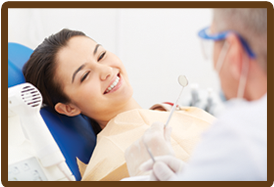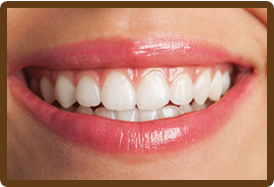ORTHODONTICS
Orthodontics is a branch of dentistry specializing in the diagnosis, prevention, and treatment of jaw, face and bite irregularities (malocclusions). Orthodontic treatment, in some cases, can be provided by a general dentist. Dr. Trujillo would be happy to help you determine what options you may have for this treatment. When it is in the patient’s best interest, Dr. Trujillo may recommend an Orthodontist. An Orthodontist has typically completed two to three years of additional training beyond dental school.
Recent years have brought about many changes within the dental industry, specifically with regards to orthodontic treatment and care. Now more than ever patients are experiencing fewer incidences of cavities and missing teeth due to the heightened awareness of fluoride use and preventative dentistry. This increasing awareness on the health and look of a patient’s smile has fueled the desire for many to seek out orthodontia not only as a medical necessity, but for cosmetic reasons as well.
Whether it’s traditional braces or custom made removable appliances, orthodontics can help you have the healthy, straight, beautiful smile you’ve been waiting for!
Call TRU Dental today and schedule your orthodontic consultation with Dr. Trujillo!
Orthodontics is one of many dental specialties. The word “orthodontics” is derived from the Greek words orthos, meaning proper or straight and odons meaning teeth. Orthodontics is specifically concerned with diagnosing and treating tooth misalignment and irregularity in the jaw area. Initially, orthodontic treatments were geared toward the treatment of teens and pre-teens, but these days around 30 percent of orthodontic patients are adults.
There are many advantages to well-aligned teeth including:
- easier cleaning
- better oral hygiene
- clearer speech
- a more pleasant smile
Though orthodontic treatment can be effective at any age, the American Dental Association suggests that an orthodontic assessment should be performed around the age of seven. The earlier orthodontic treatment begins, the more quickly the problem can be successfully resolved.
What problems can be treated with orthodontics?
Orthodontics is a versatile branch of dentistry that can be used alone, or in combination with maxillofacial or cosmetic dentistry.
Here are some of the common conditions treated with orthodontics:
- Anteroposterior deviations – The discrepancy between a pair of closed jaws is known as an anteroposterior discrepancy or deviation. An example of such a discrepancy would be an overbite (where the upper teeth are further forward than the lower teeth), or an underbite (where the lower teeth are further forward then the upper teeth).
- Overcrowding – Overcrowding is a common orthodontic problem. It occurs when there is an insufficient space for the normal growth and development of adult teeth.
- Aesthetic problems – A beautiful straight smile may be marred by a single misaligned tooth. This tooth can be realigned with ease and accuracy with orthodontics. Other options may include reshaping and restructuring the lips, jaw or the face.
Orthodontic Solutions
Orthodontics is a technologically advanced field which offers many sophisticated solutions to malocclusions and other cosmetic problems. The orthodontist will generally perform a visual examination, panoramic x-rays and study models (bite impressions) in order to assess the exact nature of the discrepancy.
When a diagnosis has been made, there are a variety of orthodontic treatment options available.
Some of the most common treatments include, but are not limited to:
- Fixed orthodontic braces – A metal or ceramic dental base is affixed to each tooth, and a dental wire is inserted through each base. The orthodontist is able to gradually train the teeth into proper alignment by regularly adjusting the wire. When the desired results are achieved, the fixed dental braces are completely removed.
- Removable appliances – There are a wide range of removable appliances commonly used in orthodontics, including but not limited to:
- headgear that correct overbites
- Hawley retainers that improve the position of the teeth even as the jawbone reforms
- facemasks which are used to correct an underbite
- Invisalign® – This is a newer, removable type of dental aligner that is completely transparent. Invisalign® does not interfere with eating because of its removable nature, and mechanically works in the same way as the traditional metal dental braces. Not all patients are candidates for Invisalign®.
If you are interested in learning more about orthodontics, please call our office at (575)526-0888 to schedule your personalized consultation with Dr. Trujillo.
A malocclusion is an incorrect relationship between the maxilla (upper arch) and the mandible (lower arch), or a general misalignment of the teeth. Malocclusions are so common that most individuals experience one, to some degree. The poor alignment of the teeth is thought to be a result of genetic factors combined with poor oral habits, or other factors in the early years.
Moderate malocclusion commonly requires treatment by an orthodontist. Orthodontists are dentists who specialize in the treatment of malocclusions and other facial irregularities.
The following are three main classifications of malocclusion:
- Class I – The occlusion is typical, but there are spacing or overcrowding problems with the other teeth.
- Class II – The malocclusion is an overbite (the upper teeth are positioned further forward than the lower teeth). This can be caused by the protrusion of anterior teeth or the overlapping of the central teeth by the lateral teeth.
- Class III – Prognathism (also known as “underbite”) is a malocclusion caused by the lower teeth being positioned further forward than the upper teeth. An underbite usually occurs when the jawbone is large or the maxillary bone is short.
Reasons for treating a malocclusion
A severe malocclusion may lead to skeletal disharmony of the lower face. In a more extreme case, the orthodontist may work in combination with a maxillofacial dentist to reconstruct the jaw. It is never too late to seek treatment for a malocclusion. Children and adults alike have completed orthodontic realignment procedures and have been delighted with the resulting even, straight smile.
Here are some of the main reasons to seek orthodontic treatment for a malocclusion:
- Reduced risk of tooth decay – A malocclusion often causes an uneven wear pattern on the teeth. The constant wearing of the same teeth can lead to tooth erosion and decay.
- Better oral hygiene – A malocclusion can be caused by overcrowding. When too many teeth are competing for too little space, it can be difficult to clean the teeth and gums effectively. It is much easier to clean straight teeth that are properly aligned.
- Reduced risk of TMJ – Temporomandibular jaw syndrome (TMJ) is thought to be caused by a malocclusion. Headaches, facial pains and grinding teeth during sleep all result from the excessive pressure to the temporomandibular joint. Realigning the teeth reduces pressure, and eliminates these symptoms.
How is a malocclusion treated?
A malocclusion is usually treated with dental braces. The orthodontist takes panoramic x-rays, conducts visual examinations and bite impressions of the whole mouth before deciding on the best course of treatment. If a malocclusion is obviously caused by overcrowding, the orthodontist may decide an extraction is the only way to create enough space for the realignment. However, in the case of an underbite, crossbite or overbite, there are several different orthodontic appliances available, such as:
- Fixed multibracket braces – This type of dental braces consists of brackets cemented to each tooth, and an archwire that connects each one. The orthodontist adjusts or changes the wire on a regular basis to train the teeth into proper alignment.
- Removable devices – There are many non-fixed dental braces available to treat a malocclusion. Retainers, headgear and palate expanders are amongst the most common. Retainers are generally used to hold the teeth in the correct position whilst the jawbone grows properly around them.
- Invisalign® – These dental aligners are removable and invisible to the naked eye. Invisalign works in much the same way as fixed dental braces, but do not impact the aesthetics of the smile. Not all patients are candidates for Invisalign®.
If you have any questions about malocclusions, please call our office at (575)526-0888 to schedule a consultation with Dr. Trujillo.
Orthodontics is a specialized branch of dentistry, concerned with diagnosing, treating and preventing malocclusions (bad bites) and other irregularities in the jaw region and face. Orthodontists are specially trained to correct these problems and to restore health, functionality and a beautiful aesthetic appearance to the smile. Though orthodontics was originally aimed at treating children and teenagers, almost one third of orthodontic patients are now adults. A person of any age can be successfully treated by an orthodontist and in many cases, a general dentist like Dr. Trujillo.
A malocclusion (improper bite) can affect anyone at any age, and can significantly impact the individual’s clarity of speech, chewing ability and facial symmetry. In addition, a severe malocclusion can also contribute to several serious dental and physical conditions such as digestive difficulties, TMJ, periodontal disease and severe tooth decay. It is important to seek orthodontic treatment early to avoid expensive restorative procedures in the future.
What problems can orthodontics treat?
Orthodontics can treat a wide range of dental problems and in most cases, completely realign the teeth.
The typical irregularities requiring orthodontic treatment are as follows:
- Overcrowding – An overcrowded mouth means there is insufficient space within the jaw for all of the adult teeth to fit naturally. Overcrowding may lead to displaced, rotated or completely misaligned teeth.
- Overbite – An overbite refers to the protrusion of the maxilla (upper jaw) relative to the mandible (lower jaw). An overbite gives the smile a “toothy” appearance and the chin looks like it has receded.
- Underbite – An underbite, also known as a negative underjet, refers to the protrusion of the mandible (lower jaw) in relation to the maxilla (upper jaw). An underbite makes the chin look overly prominent. Developmental delays and genetic factors generally cause underbites and overbites.
How can orthodontics help?
Orthodontic dentistry offers techniques which will realign the teeth and revitalize the smile. There are several treatments that may be used, depending on the results of panoramic x-rays, study models (bite impressions) and a thorough visual examination.
- Fixed dental braces can be used to expediently correct even the most severe case of misalignment. These braces consist of metal or ceramic brackets which are affixed to each tooth and an archwire which is used to gradually move the teeth through the duration of the treatment.
- Removable appliances include headgear (which consists of a metal wire device attached to customized braces), retainers, Invisalign® aligners (which are almost invisible to the naked eye), palate expanders and tooth movers. Faceguards are generally used to correct developmental delays in both the upper and lower jaw, and palate expanders are used to combat overcrowding.
Whatever the dental irregularity or the age of the individual, orthodontic appliances can properly realign the teeth and create a beautiful smile.
If you are interested in learning more about your orthodontic options, call us at (575)526-0888 to schedule a consultation with Dr. Trujillo.
The benefits of orthodontic treatment often go beyond the obvious physical changes of an improved bite and straighter teeth; it’s also a great way to improve a person’s overall self-image. While having beautiful straight teeth is important, even more important is the need to alleviate any potential health problems associated with the teeth or jaw. Crooked teeth or jaw problems may contribute to improper cleaning of teeth, leading to tooth decay and, possibly, gum disease or total tooth loss.
Orthodontic problems that go untreated can lead to:
- chewing and digestion difficulties
- speech impairments
- abnormal wear of tooth surfaces
- Over time, excessive strain on gum tissue and the bone that supports the teeth can affect the jaw joints leading to problems such as headaches or face and neck pain.
The American Association of Orthodontics recommends that children get an orthodontic evaluation no later than age 7. Though orthodontic treatment can be done at any age, timely treatment ensures maximum dental health.
With all of the recent advancements in orthodontics, wearing braces has never been easier. State-of-the-art appliances and treatments are now available, from traditional metal braces, to clear and tooth colored brackets, to NASA type wires that are heat activated and require fewer adjustments. Some patients may even be candidates for treatment with Invisalign, a revolutionary way to straighten teeth using clear, retainer type aligners that require no braces or wires!
If treatment is necessary, Dr. Trujillo can explain which treatment option is best suited for you!
Reasons for orthodontic treatment (braces) adults & children:
- Breathing or swallowing problems – Mouth breathing can lead to snoring and sleep apnea.
- Crossbite – One or more upper teeth bite inside the lower teeth (towards the tongue).
- Crowding – Involving extra teeth or malpositioned teeth.
- Deep Overbite – The lower front teeth bite into the upper tissue of the upper teeth.
- Disfiguring of the face & mouth – Affects the development of the jaw and position of the teeth.
- Jaw & jaw joint pain
- Missing or extra teeth – Due to tooth decay, injuries, or inherited problems.
- Overjet (protruding upper teeth) – Upper teeth that protrude beyond normal and are usually associated with a short lower jaw.
- Self-image – An attractive smile can boost a person’s self-image and confidence.
- Spacing between teeth – Teeth are missing or may be too small or too large.
- Speech, chewing or biting problems
- Underbite (lower jaw protrusion) – Lower jaw is longer than the upper jaw.
Specific to children:
- Finger or thumb sucking – These habits can cause protrusion of the upper incisor teeth, and mouth breathing.
- Teeth erupting out of position – Can be guided to proper alignment.
What does orthodontic treatment involve?
Orthodontic treatment involves three phases:
1. Planning Phase – Your first couple of visits may include:
- A medical and dental history evaluation.
- Castings or “molds” of your teeth.
- Computer generated photograph of the head and neck that will aid in planning.
- Photographs of your face and mouth.
- X-rays of the teeth and jaws.
After careful planning, custom-made appliances will be fabricated, if needed.
2. Active Phase – Active treatment involves regular visits for adjustments and following specific treatment requirements to ensure successful treatment.
3. Retention Phase – When treatment is completed, the braces and/or appliances are removed and a new appliance is made. Usually these retainers are removable and will maintain the changes made to your teeth if worn continuously until the teeth and bone are stabilized in their new positions.
Treatment and retention times vary depending on each individual case.
Orthodontics can not only help straighten your teeth, giving you an appealing smile, but can greatly contribute to the health of your jaw, teeth and sometimes your overall health.
One of the most commonly asked questions about dental braces is whether placing them causes any pain or discomfort. The honest answer is that braces do not hurt at all when they are applied to the teeth, so there is no reason to be anxious. In most cases, there may be mild soreness or discomfort after the orthodontic wire is engaged into the brackets, which may last for a few days.
There are two common types of fixed dental braces used to realign the teeth:
- Ceramic fixed braces
- Metal fixed braces
Both types of fixed appliances include brackets which are affixed to each individual tooth, and an archwire the orthodontist fits into the bracket slot to gently move the teeth into proper alignment. Elastic or wire ties will be applied to hold the wire in place. Some orthodontists may use self-ligating brackets which do not require a rubber or wire tie to secure the wire.
Fixed dental braces are used to treat a wide variety of malocclusions, including overbite, underbite, crossbite and overcrowding. If it is determined the malocclusion has been caused by overcrowding, it is possible that teeth may need to be extracted to increase the amount of available space to properly align the teeth.
What to expect when getting braces
Here is an overview of what you can expect when getting braces:
- Placement day – The placement of braces will not be painful in the slightest. It may take longer to eat meals, but this is largely because it takes some time to adjust to wearing the braces. In some cases, the teeth may feel more sensitive than usual. Hard, difficult to chew foods should be avoided in favor of a softer, more liquid-based diet for the first few days after placement of braces.
- Two days after placement – The first several days after placement of braces can be slightly uncomfortable. This is because the teeth are beginning the realignment process and are not used to the pressure of the archwire and orthodontic elastic bands. The orthodontist will provide relief wax to apply over the braces as necessary. Wax helps provide a smooth surface and alleviates irritation on the inner cheeks and lips. Additionally, over-the-counter pain medication (e.g., Motrin® and Advil®) may be taken as directed to relieve mild soreness.
- Five days after placement – After five days, any initial discomfort associated with the braces should be completely gone. The teeth will have gradually acclimated to the braces, and eating should be much easier. Certain hard foods may still pose a challenge to the wearer, but normal eating may be resumed at this point.
- Orthodontic appointments – Regular orthodontic appointments are necessary to allow the orthodontist to change the archwire, change the rubber or metal ties, and make adjustments to the braces. Fixed braces work by gradually moving the teeth into a new and proper alignment, so gentle pressure needs to be applied constantly. The first several days after an orthodontic adjustment may be slightly uncomfortable. Remember, this discomfort will quickly fade.
- Dealing with discomfort – Over-the-counter pain medication and orthodontic relief wax will help alleviate any mild soreness and discomfort following placement of braces and orthodontic adjustments. Another effective remedy is to chew sugar-free gum, as this increases blood flow which helps reduces discomfort and can also encourage the teeth to align quicker.
Our office can be reached at (575)526-0888 to address any questions you may have.
When braces are finally removed, the “retention” phase begins for most individuals. The objective of this phase is to ensure the teeth do not regress back to their previous position. A retainer will be used to maintain the improved position of the teeth. A retainer is a fixed or removable dental appliance which has been custom-made by the orthodontist to fit the teeth. Retainers are generally made from transparent plastic and thin wires to optimize the comfort of the patient.
Retainers are worn for varying amounts of time, depending on the type of orthodontic treatment and the age of the patient. Perseverance and commitment are required to make this final stage of treatment successful. If the retainer is not worn as directed by the orthodontist, treatment can fail or take much longer than anticipated.
What types of retainer are available?
There are a variety of retainers available; each one geared towards treating a different kind of dental problem. The orthodontist will make a retainer recommendation depending on the nature of the original diagnosis and the orthodontic treatment plan.
The following are some of the most common types of retainers:
- Hawley retainer – The Hawley retainer consists of a metal wire on an acrylic arch. The metal wire may be periodically adjusted by the orthodontist to ensure the teeth stay in the desired position. The acrylic arch is designed to fit comfortably on the lingual walls or palate of the mouth.
- Essix – The Essix retainer is the most commonly used vacuum formed retainer (VFR). A mold is initially made of the teeth in their new alignment, and then clear PVC trays are created to fit over the arch in its entirety. VFR’s are much cheaper than many other types of retainers and also do not affect the aesthetic appearance of the smile in the same way as the Hawley retainer. The disadvantage of VFR’s is that they break and scratch more easily than other types of retainers.
- Fixed retainers – A fixed retainer is somewhat similar to a lingual brace in that it is affixed to the tongue side of a few teeth. Usually, a fixed retainer is used in cases where there has been either rapid or substantial movement of the teeth. It usually consists of a single wire. The inclination of the teeth to move rapidly means they are also more likely to regress back to their previous position if a fixed retainer is not placed.
What do I need to consider when using a retainer?
There are a few basic things to consider for proper use and maintenance of your retainer.
- Don’t lose the appliance – Removable retainers are very easy to lose. It is advisable to place your retainer in the case it came in while eating, drinking and brushing. Leaving a retainer folded in a napkin at a restaurant or in a public restroom can be very costly if lost because a replacement must be created. A brightly colored case serves as a great reminder.
- Don’t drink while wearing a retainer – It is tempting to drink while wearing a retainer because of the unobtrusive nature of the device. However, excess liquid trapped under the trays can vastly intensify acid exposure to teeth, increasing the probability of tooth decay.
- Don’t eat while wearing a retainer – It can be difficult and awkward to eat while wearing a removable retainer and it can also damage the device. Food can get trapped around a Hawley retainer wire or underneath the palate, causing bad breath. When worn on the upper and lower arches simultaneously, VFR retainers do not allow the teeth to meet. This means that chewing is almost impossible.
- Clean the retainer properly – Removable retainers can become breeding grounds for calculus and bacteria. It is essential to clean the inside and outside thoroughly as often as possible. Hawley retainers can be cleaned with a toothbrush. Because harsh bristles can damage the PVC surface of a VFR, denture cleaner or a specialized retainer cleaner is recommended for this type of device.
- Wear the retainer as directed – This phase of treatment is critical. The hard work has been done, the braces are off and now it is tempting not to wear the retainer as often as the orthodontist recommends. Retainers are needed to give the muscles, tissues and bones time to stabilize the teeth in their new alignment. Failure to wear the retainer as directed can have regrettable consequences, such as teeth returning to their original position, added expense and lost time.
If you have any questions or concerns about retainers, please contact our office.
One of the primary concerns people often have about dental braces is the aesthetic impact of the metalwork on their smile. Especially for adults, the prospect of wearing unattractive metal braces for long periods of time can be very discouraging. Invisalign® offers an almost invisible aligning system that straightens teeth fast and contains no metal.
Invisalign® treatment consists of a series of custom-made aligning trays. The dentist changes the trays every several weeks to fit the new tooth configuration. In addition to the reduced visual impact, Invisalign® aligning trays can be temporarily removed for important occasions – meaning that treatment duration is patient-controlled. A great number of people report complete satisfaction with both the Invisalign® treatment and the stunning results.
What kind of bite problems can Invisalign® correct?
Invisalign® corrects the same dental problems as traditional metal braces; the only difference is that Invisalign® trays are almost invisible to the naked eye, and can be removed at will.
Here are some problems that are commonly corrected with Invisalign®:
- Overcrowding – This occurs when there is too little space for the teeth to align normally in the mouth. Overcrowding can cause tooth decay and increase the likelihood of gum disease.
- Large gaps between teeth – This can sometimes occur because teeth are missing or because the jaw continues to grow abnormally.
- Crossbite – This common dental problem occurs when one or multiple upper teeth bite inside the lower teeth. As a consequence, uneven wear can lead to bone erosion and gum disease.
- Overbite – This problem occurs when the upper teeth project further than, or completely cover, the lower teeth. Eventually, jaw pain and TMJ may occur.
- Underbite – This is the inverse of the overbite; the lower teeth project further than, or completely cover, the upper teeth. Eventually, jaw pain and TMJ can occur.
What advantages does Invisalign® offer over traditional braces and veneers?
Traditional dental braces, Invisalign® aligning trays and dental veneers are three different ways to perfect the alignment of the teeth. There are many different considerations to make when considering which treatment will be best, and each of these options works better in certain situations.
Invisalign® differs from traditional braces in that the aligning trays are fully removable. This means that more discipline and commitment is required from the patient. This is not usually a problem since the trays are comfortable and nearly invisible. Almost identical results can be obtained by using either treatment.
Invisalign® is preferable to veneers in many cases because unlike veneers, Invisalign® actually straightens the teeth. Veneers are thin covers that the dentist permanently affixes to the teeth. Teeth must be etched beforehand, meaning that to remove dental veneers, an alternative covering must be constructed. In addition to being somewhat expensive, veneers can break and often last for less than 20 years.
What does Invisalign® treatment involve?
First, the dentist needs to devise an initial treatment plan before creating the special aligning trays. Three-dimensional digital images are taken of the entire jaw. These images allow the dentist to move specific teeth on the screen, view the jaw from different angles, and also foresee what the face might look like in years to come. In essence, this technology can show how Invisalign® trays will change the facial aesthetics.
Once planning is complete, a unique set of aligners is made. The total amount of aligners required varies with each individual case, but 20-29 sets per arch is typical.
What are some considerations when wearing Invisalign® trays?
Life with Invisalign® aligning trays may take several weeks to get used to. The trays should be worn constantly, except when eating and drinking. It is important to remove the trays when consuming food or drink because food can become trapped between the tray and the teeth, causing tooth decay.
Usually, new trays are necessary every two weeks and progress between appointments can be seen with the naked eye. There is no doubt that Invisalign® aligning trays have revolutionized orthodontics. Invisalign® is renowned for being both comfortable and effective.
If you have questions about Invisalign®, please ask your dentist.
Straighter teeth perform chewing, biting and speaking functions more effectively than crooked teeth. In addition, a straight smile boosts confidence, is aesthetically pleasing to look at, and can help stave off a wide variety of dental ailments.
There are several types of malocclusion including overbite, underbite, crossbite, and overcrowding. Each of these alignment problems negatively impacts the functionality and cosmetic appearance of the teeth.
Here is a brief overview of some of the main disorders associated with crooked teeth:
Periodontitis – Periodontitis or gum disease begins with a bacterial infection. The bacterial infection is caused by inadequate oral hygiene. Crooked teeth are hard to clean effectively, which means that debris, plaque and bacteria can build up in hard-to-reach areas. Straight teeth are much easier to clean and are at less risk of contracting gum disease.
Temporomandibular Disorder (TMJ) – Crooked teeth can lead to improper jaw alignment, which in turn causes a painful condition known as TMJ. Severe headaches, jaw pain, lockjaw and the grinding of teeth characterize this debilitating disorder.
Tooth injury – Straight teeth creates a strong wall, which means injuries are less likely to occur. Crooked teeth are weaker and often protrude, making them far more vulnerable to external injury.
Uneven wear – Crooked teeth cause some of the teeth to work harder than others when biting and chewing. Straight teeth share the workload evenly, meaning less risk of injury and better aesthetics.
Teeth can be straightened using either orthodontic braces or customized aligning trays. Orthodontic braces are usually affixed to the teeth for a set duration. The brackets and archwires are tightened regularly by the orthodontist and removed when treatment is complete. Fixed braces can be placed on the front side or back side of the teeth and are effective for most types of malocclusion.
Aligning trays are fully removable and are used where the malocclusion is less severe, and the teeth need to move a shorter distance. These trays are replaced every few weeks for the duration of the treatment, and have proven to be equally effective for straightening teeth.
If you have questions about orthodontics and straightening teeth, please ask your orthodontist.















